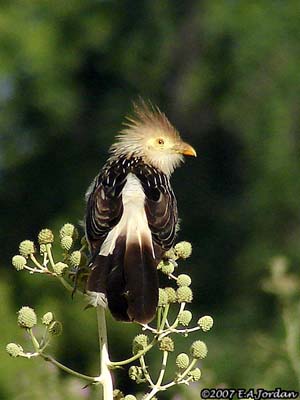
Guira Cuckoo
Guira guira
Cuculiforme Order – Cuculidae Family
BIOMETRICS:
Length: 36 cm
Weight: 140-143 g
DESCRIPTION:
The Guira Cuckoo is a non-parasitic cuckoo which often nests in community.
Adult has white-streaked brown back and wings. Lower back and uppertail coverts are white.
The long tail is blackish with broad white area at the base, and white tips. Central rectrices are dark, except at the base.
Fr : Guira cantara
All : Guirakuckuck
Esp : Pirincho
Ital: Cuculo Guira
Nd: Zuidamerikaanse Kuifkoekoek
Russe: Гуйра
Port: Anu-branco
Photographers :
Philippe et Aline Wolfer
GALERIE
Marc Chrétien
MURINUS
Eduardo Andrés Jordan
MIS AVES – AVES DE ARGENTINA
Text by Nicole Bouglouan
Sources :
HANDBOOK OF THE BIRDS OF THE WORLD vol 4 by Josep del Hoyo-Andrew Elliott-Jordi Sargatal - Lynx Edicions - ISBN: 8487334229
Wikipedia (Wikipedia, The Free Encyclopedia)

On the underparts, throat and breast are whitish, finely streaked dark brown. Rest of underparts are buffy-white.
Underwing and undertail feathers are similar to upper feathers.
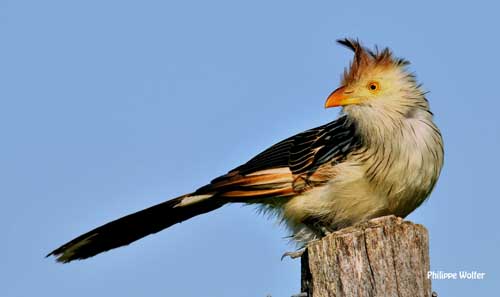
The shaggy-looking head shows long orange-rufous crest. The bare parts of the face are yellow, including the eye-ring.
The strong bill is orange with yellow base on lower mandible, but it may be pale yellowish according to the birds. Eyes are orange to yellow, and also may vary to pale yellow, like the bill. Legs and feet are bluish-grey.
Both sexes are similar.
The juvenile resembles adults, but it has white spots on the flight feathers’ tips. The bill is black and white. The eyes are pale grey.

VOICE:
The Guira Cuckoo is a noisy bird. It usually utters plaintive whistles “pio…pio…pr…prr…prrr”. We can also hear more guttural calls, high-pitched gurgling trills and a “creep”.
Calls are used by males to announce the territory and in courtship. The sounds can be varied and uttered rapidly all day long during the breeding season.
Groups of Guira Cuckoos give harsh calls in communal defence of territory against other groups, often accompanied by bill-clicks and chatters in aggressive disputes.
This species is also able to imitate other birds’ calls.
HABITAT:
The Guira Cuckoo frequents dry mixed tree and scrub savannahs, scrub woodlands, pampas (temperate grasslands, savannahs and scrubs), pastures and coastal dunes.
This species occurs from sea-level up to 1200 metres of elevation.
RANGE:
The Guira Cuckoo is found in E and S Brazil, W to Bolivia and Paraguay, and S to Uruguay and N and E Argentina.
It is resident in the habitat.
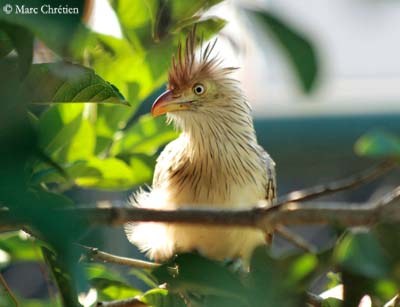
BEHAVIOUR:
The Guira Cuckoo is a gregarious species. It often feeds on the ground in flocks of up to 20 birds. This species feeds mainly on insects, frogs, eggs and chicks of small birds’ species.
It commonly forages on the ground in meadows and pastures, in dry open habitats. In social groups, the birds forage near each other and stay in contact by squeaky calling.
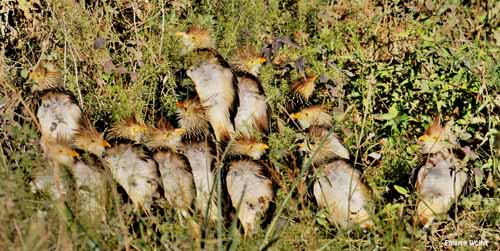
The Guira Cuckoos are highly social, perching and roosting in contact. They press against each other and indulge in allopreening.
They remain in groups throughout the year. They defend their territories against other flocks of the same species, and gives harsh calls.
The Guira Cuckoo performs courtship displays at the beginning of the breeding season. They spread and raise the tail to display the plumage pattern such as the white spots of the rectrices. The long crest is raised too.
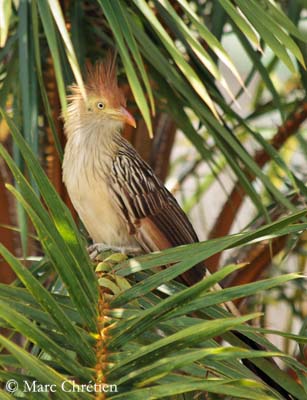
The Guira Cuckoo, as the Smooth-billed Ani and the Greater Ani, performs co-operative breeding where more than one female lays in the same nest. Numerous eggs are lost, and chicks may be removed from the nest by some adults. The young birds may kill the nestlings. Actually, there is no more fledged young in the communal nests of larger groups than in other groups, due to the competition between breeding adults.
An adult remains at nest as sentinel while the other group’s members are away for feeding. If a predator approaches, the sentinel gives loud calls, and the other birds converge on the nest for defence.
FLIGHT:
The Guira Cuckoo performs a graceful flight, described as “recalling a kite in the wind”!
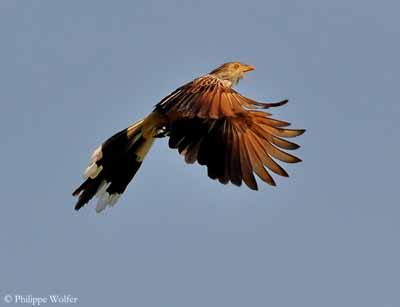
REPRODUCTION:
Breeding season occurs mainly in rainy period.
The Guira Cuckoo lives and breeds in groups but in spring, pairs are forming.
The nest is situated high in thorny tree. It is a large platform made with sticks. The nests of the previous year often are reused.
Usually, several females lay in the same nest, and often, there are up to 10 grey to turquoise eggs with white chalky markings, sometimes more in larger groups.
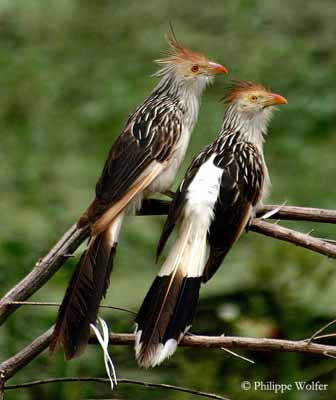
Incubation lasts between 10 and 15 days. The white chalky markings would allow each female to recognize her own eggs. But adults remove some eggs and drop them on the ground. Eggs are lost during the laying and the incubation, and there is much conflict and competition among the breeding adults.
However, several chicks hatch. They are paler in colour overall. They may leave the nest very soon (5-6 days after hatching) if disturbed, but usually, they fledge two weeks later. They are fed by some adults. About half of the chicks survive to fledging.
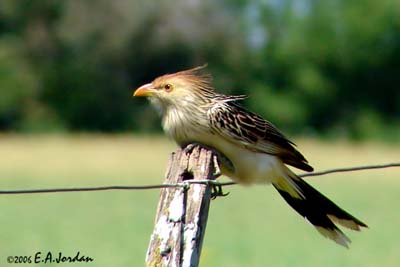
DIET:
The Guira Cuckoo feeds mainly on insects, grasshoppers, cicadas and flying termites. They also take frogs, eggs and chicks of small birds’ species. They feed on the ground in flocks of about 20 birds.
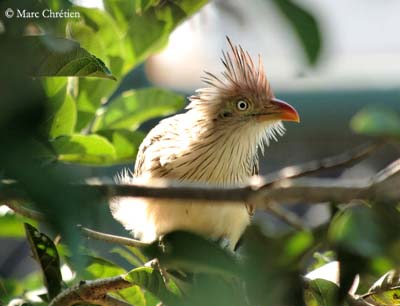
PROTECTION / THREAT / STATUS:
The Guira Cuckoo is usually common in its range which has extended in the last century.
This species is not threatened at this moment.
